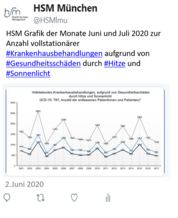Treatment Patterns with Anti-Dementia Drugs in the United States: Medicare Cohort Study
| Autoren/Herausgeber: |
Koller, D. Hua, T. Bynum, J.P. |
|---|---|
| Erschienen: | 2016 |
| Publikationsart: | Articles in Refereed Journals (International) |
| ISBN/ISSN: | http://dx.doi.org/10.1111/jgs.14226 |
| erschienen in: | J. Am. Geriatr. Soc. |
Abstract
Objectives:
To evaluate frequency of use of two anti-dementia drug classes approved for treatment of symptoms, whether populations most likely to benefit are treated, and correlates of treatment initiation.
Design:
Nationally representative cohort study.
Setting:
Fee-for-service Medicare.
Participants:
Elderly adults with dementia enrolled in Medicare Parts A, B, and D in 2009 (N = 433,559) and a subset with incident dementia (n = 185,449).
MEASUREMENTS:
Main outcome was any prescription fill for antidementia drugs (cholinesterase inhibitors (ChEIs) or memantine) within 1 year.
Results:
Treatment with antidementia drugs occurred in 55.8% of all participants with dementia and 49.3% of those with incident dementia. There was no difference between ChEIs and memantine use according to dementia severity (measured as death within first year or living in residential care vs in a community setting) even though memantine is not indicated in mild disease. In incident cases, initiation of treatment was lower in residential care (relative risk (RR) = 0.82, 95% confidence interval (CI) = 0.81-0.83) and with more comorbidities (RR = 0.96, 95% CI = 0.96-0.96). Sixty percent of participants were managed in primary care alone. Seeing a neurologist (RR = 1.07, 95% CI = 1.06-1.09) or psychiatrist (RR = 1.17, 95% CI = 1.16-1.19) was associated with higher likelihood of treatment than seeing a primary care provider alone, and seeing geriatrician was associated with with lower likelihood (RR = 0.96, 95% CI = 0.93-0.99). Across the United States, the proportion of newly diagnosed individuals started on antidementia treatment varied from 32% to 66% across hospital referral regions.
Conclusions:
Antidementia drugs are used less often in people with late disease, but there is no differentiation in medication choice. Although primary care providers most often prescribe antidementia medication without specialty support, differences in practice between specialties are evident.





